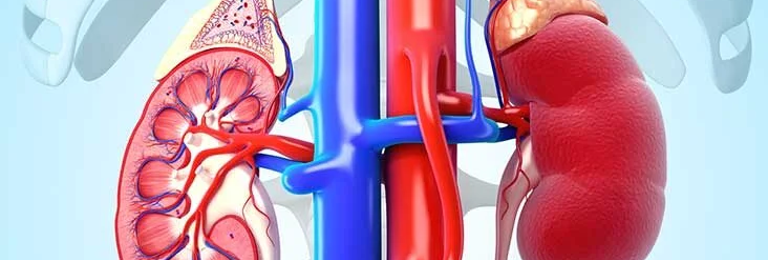The kidneys are dark red, paired parenchymal organs located on the sides of the spinal column in the retroperitoneal area, that is, between the peritoneum and the posterior wall of the abdomen. Together with the ureters, the bladder, and the urethra, they form the urinary tract. They have the function of producing urine, regulating the volume and osmolarity of body fluids, regulating the acid-base and hydroelectrolytic balance, producing hormones, and eliminating catabolites.
kidney anatomy
The kidneys are bean-like in shape, about 12 cm long, 6 cm wide and 3 cm thick, and weigh an average of 150-170 g (on average slightly less in females), and the left kidney tends to be 1-1 longer than the right 1.5 cm. Both lie between thoracic vertebra 11 and lumbar vertebra 3, with the right kidney slightly lower due to the presence of the liver. They reach their maximum volume at 25-30 years of age and in the elderly they change their appearance, tending to atrophy.
The kidneys are surrounded by a fatty capsule delimited by the renal fascia, of a connective nature, which together with the vascular peduncle keeps them in place. Together with its capsule, each kidney is surrounded by another fibrofatty band, called the perirenal capsule, which delimits a virtual space called the renal fossa, whose anterior wall is formed by Gerota's fascia, while the posterior wall is formed by Zuckerkandl's fascia. . . The renal artery and vein, as well as nerves and lymphatic vessels enter the kidneys through the hilum, located on the medial border of the fossa.
The renal parenchyma is divided into:
- cortical area, externally. It forms the renal columns of Bertin, which go towards the renal sinus interposing between the Malpighian pyramids.
- the medullary area, internally. It is formed precisely by the renal pyramids that, through the renal calyces, conduct urine to the renal pelvis and from there to the ureter.
The functional anatomical microscopic unit of the kidney is the nephron; each kidney contains about a million nephrons that are composed of the glomerulus and the tubule.
The glomerulus, contained in Bowman's capsule, is made up of coiled capillaries that originate from the afferent arteriole and flow into the efferent arteriole. The tubule empties into the collecting ducts.
Bowman's capsule has the function of collecting the pre-urine filtered by the capillaries that form the glomerulus and pouring it into the renal tubules, which seem to be formed by different sectors: the proximal convoluted tubule, the descending branch of the loop of Henle, the ascending and distal convoluted tubule.
Renal vascularization is very rich: the kidneys filter about 1200 ml of blood per minute, to allow the function of filtration and urine production, receiving 20% of the cardiac output.
The innervation is given by the branches of the celiac plexus, by the splanchnic and renal aortic nerves, which form the renal plexus following the course of the renal artery.
Kidney Functions
The main functions of the kidney are:
- hydroelectrolytic homeostasis;
- the elimination of wastes (end products of metabolism such as urea, uric acid and excess H+ ions, drugs and exogenous substances).
The basic processes that take place in the nephron are: filtration, reabsorption/secretion, and excretion.
Each nephron is capable of carrying out the aforementioned processes completely independently. Specifically, to ensure a correct hydroelectrolytic balance, the kidney regulates the concentration of sodium, potassium, chlorine, calcium, phosphorus and bicarbonate. It also regulates the glucose content, reabsorbing it at the tubular level; when blood sugar exceeds 180 mg/dl, the excess glucose cannot be reabsorbed, thus producing glycosuria (passage of glucose into the urine). For every minute, 700 ml of plasma pass through the kidney, of which 125 ml are filtered, producing 180 liters of pre-urine per day. Of this impressive volume, less than 1% (about 1.5 liters per day) is excreted, while the rest is reabsorbed. Thanks to the large volume of fluid that passes through them, the kidneys can actively intervene to regulate the concentrations of all substances contained in the plasma.
The kidney also produces essential hormones in the control of blood volume/diuresis, through the juxtraglomerular apparatus and the macula densa, such as renin, which is indirectly involved in the control of blood pressure.
Finally, the kidneys produce other hormones and other molecules: the active form of vitamin D (1,25 dihydroxy-cholecalciferol, involved in calcium metabolism and bone homeostasis), erythropoietin (for the production of red blood cells), prostaglandins and other signaling molecules.


